Affordable Dual Core from AMD: Athlon 64 X2 3800+
by Anand Lal Shimpi on August 1, 2005 9:36 AM EST- Posted in
- CPUs
The Test
Our hardware configurations are similar to what we've used in previous comparisons. For this test, we focused on CPUs at or around the Athlon 64 X2 3800+'s $354 price point.AMD Athlon 64 Configuration
Socket-939 Athlon 64 CPUs
2 x 512MB OCZ PC3200 EL Dual Channel DIMMs 2-2-2-7
ASUS A8N-SLI Deluxe
ATI Radeon X850 XT PCI Express
Intel Pentium 4 Configuration
LGA-775 Intel Pentium 4 and Pentium D CPUs
2 x 512MB Crucial DDR-II 533 Dual Channel DIMMs 3-3-3-12
Intel 925XE Motherboard
ATI Radeon X850 XT PCI Express
Business/General Use Performance
Business Winstone 2004
Business Winstone 2004 tests the following applications in various usage scenarios:. Microsoft Access 2002
. Microsoft Excel 2002
. Microsoft FrontPage 2002
. Microsoft Outlook 2002
. Microsoft PowerPoint 2002
. Microsoft Project 2002
. Microsoft Word 2002
. Norton AntiVirus Professional Edition 2003
. WinZip 8.1
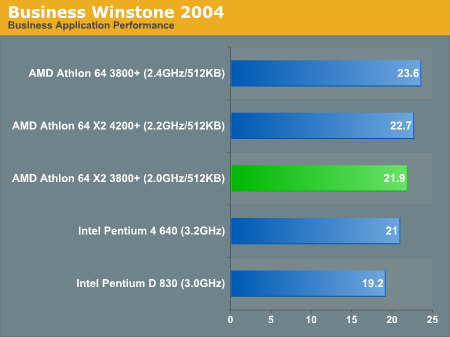
Office Productivity SYSMark 2004
SYSMark's Office Productivity suite consists of three tests, the first of which is the Communication test. The Communication test consists of the following:"The user receives an email in Outlook 2002 that contains a collection of documents in a zip file. The user reviews his email and updates his calendar while VirusScan 7.0 scans the system. The corporate web site is viewed in Internet Explorer 6.0. Finally, Internet Explorer is used to look at samples of the web pages and documents created during the scenario."
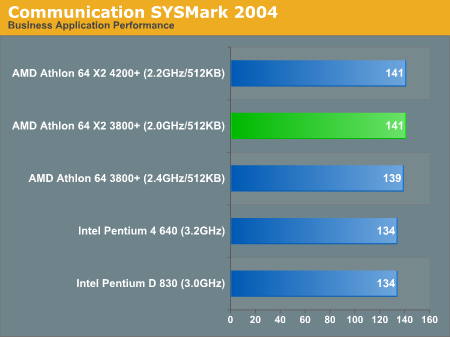
"The user edits the document using Word 2002. He transcribes an audio file into a document using Dragon NaturallySpeaking 6. Once the document has all the necessary pieces in place, the user changes it into a portable format for easy and secure distribution using Acrobat 5.0.5. The user creates a marketing presentation in PowerPoint 2002 and adds elements to a slide show template."
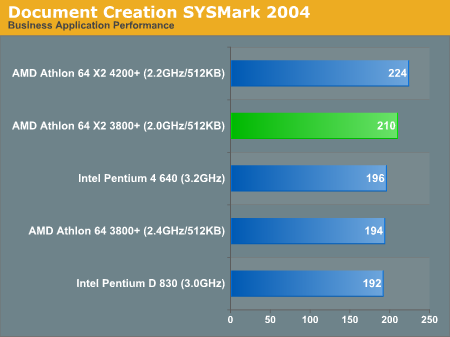
"The user opens a database using Access 2002 and runs some queries. A collection of documents are archived using WinZip 8.1. The queries' results are imported into a spreadsheet using Excel 2002 and are used to generate graphical charts."
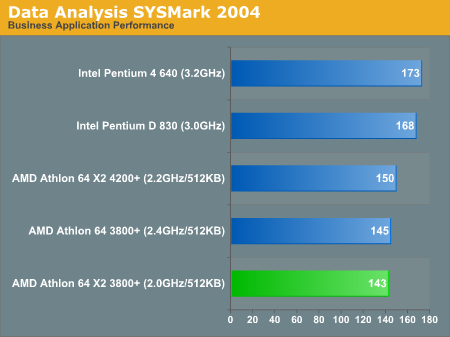
Microsoft Office XP SP-2
Here, we see in that the purest of office application tests, performance doesn't vary all too much. 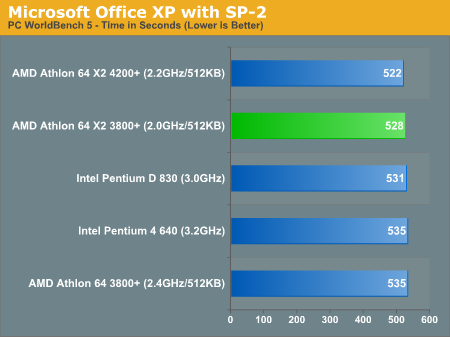
Mozilla 1.4
Quite possibly the most frequently used application on any desktop is the one that we pay the least amount of attention to when it comes to performance. While a bit older than the core that is now used in Firefox, performance in Mozilla is worth looking at as many users are switching from IE to a much more capable browser on the PC - Firefox. 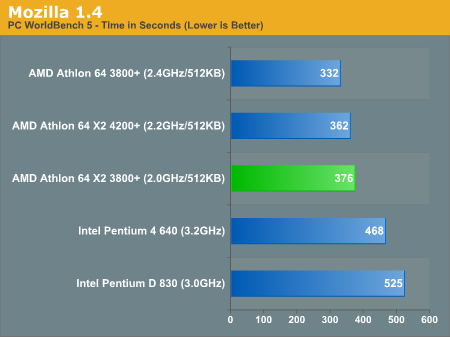
ACD Systems ACDSee PowerPack 5.0
ACDSee is a popular image editing tool that is great for basic image editing options such as batch resizing, rotating, cropping and other such features that are too elementary to justify purchasing something as powerful as Photoshop. There are no extremely complex filters here, just pure batch image processing. 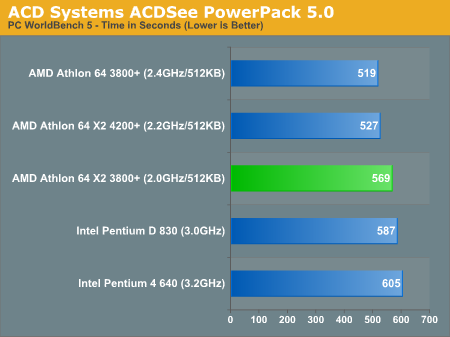
Winzip
Archiving performance ends up being fairly CPU bound as well as I/O limited. 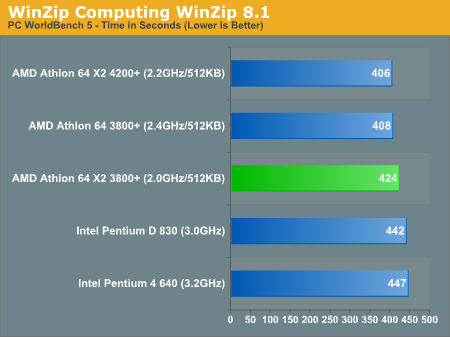
WinRAR 3.40
Pulling the hard disk out of the equation, we can get a much better idea of which processors are truly best suited for file compression. 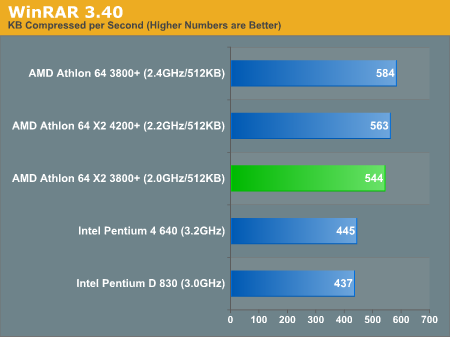










109 Comments
View All Comments
Houdani - Monday, August 1, 2005 - link
By that same logic, should Intel cut prices on the Pentium D 830, 840, and EE down to the same price as the Pentium D 820? Of course not, because with higher performance comes higher prices.Sure, AMD could release a 1.8GHz X2 3400+ at a $250 price point to cross with the Pentium D 820, but before that happens they'll continue to make a profit with what they've got before introducing a new chip which has been artificially gimped in order to meet the needs of the low end/entry market.
still - Monday, August 1, 2005 - link
Except that by the time you get a new motherboard that supports that cheaper Intel chip and the pricier DDR2 memory, any price advantage Intel had is already gone. And the AMD system still outperforms the Intel one 15% in for the 830D and 20% in the 820D. So choose wisely...SDA - Monday, August 1, 2005 - link
You know what's funny? Most of the customers I've had were more than happy to pay extra to have a PC that ran very quiet and cool. All of them said they'd like that, actually, but most of them added that they wouldn't mind a hefty premium. So do you think these customers would bite if I told them that $100 would buy them a faster, more capable, and cooler-running processor?Oh, it's expensive, to be sure. But saying that no one will ever want it just because you don't is, well, stupid.
fishbits - Monday, August 1, 2005 - link
"one major flaw in AMD's execution: price""AMD's Athlon 64 X2 was the better overall performer, just at the very wrong price point."
Anand, I wish you and the rest would seriously sit down and think about all the sniping and whining you've done lately about the prices of high(er)-end products. How, exactly, was AMD's price execution flawed? They can only make so many of the X2 chips, and they have been flying off the shelves at and above their suggested price. It's not like AMD's "flaw" was pricing them so high no one was buying them and they were gathering cobwebs in warehouses. What's "wrong" about this price point?
Let's look at it this way, is AnandTech "flawed" and "wrong" in its advertising pricing? I mean you could sell front-page add space for $5 per month. Or do you charge a reasonable price that keeps ads to a reasonable (non-overwhelming) number of ads on a page, without pricing so high that there's huge droughts of no ad revenue?
I couldn't care less if you were to deem products "too high to recommend to most users for their budgets and needs" and the such. But it's pretty petty that you and the crew constantly take slaps at products and their manufacturers because they're priced higher than we'd WISH they'd be, but still selling quite well and making those who can afford them quite happy. A new Corvette costs more than a Neon. This isn't "flawed" or "wrong." It's just another factor to take into consideration when purchasing and recommending. Now if something is seriously overpriced for its ability, by all means point it out. But stop coming across like you have no clue that the prices for higher-end parts ramp up quite steeply, and deservedly and understandably so. Been this way for decades and will continue to be this way for decades to come.
masher - Monday, August 1, 2005 - link
From AMD's perspective, there may be nothing "wrong" with pricing X2 chips far higher than two equivalent single CPUS...but from the consumer's persective, such a price point is most certainly flawed.So are you a consumer or an AMD stockholder? It should be obvious that-- for the average consumer-- a second core priced far above the first is a poor purchasing decision, and that such pricing will never lead to significant market penetration.
fishbits - Monday, August 1, 2005 - link
But that's just it, AnandTech is taking the stance that it is wrong from AMD's perspective, not from the consumer's. That is where I think they've gone off track. As far as a second core being priced far above the first, color me unfazed. If somehow AMD or Intel were able to bump single-core clock speed by 50%, would any of us be suprised that the new chip would cost (gasp!) AT LEAST double the price? On a dollars-per-Mhz scale, of course it's a loser. On a "getting my hands on a high-end performer" scale, it's easily a winner at double the price. Look at how much more we pay for just a 20% bump in single-core clock speed, and yet it doesn't generate the kind of whining that adding a whole second core and cache does."...Such pricing will never lead to significant market penetration".
Funny, last I heard X2s were selling very well, especially when measured against AMD's ability to produce them. As always, when production ramps up the cost will go down.
The other thing I'd add is that it's my understanding that the 820, a very good performer for its price, is that it's a subsidized chip. I gather (though could be wrong) that Intel sells them for zero profit, or even loses money on them to bump up market share. If that's the case, then its pricing is somewhat an exception and that should be provided as appropriate context in any comparison as Intel has the size and cash to do this, where AMD doesn't.
masher - Monday, August 1, 2005 - link
> "But that's just it, AnandTech is taking the stance that it is wrong from AMD's perspective..."I think you're reading your own bias into his statements.
> "Funny, last I heard X2s were selling very well, especially when measured against AMD's ability to produce them..."
Actually, they are selling well ONLY when measured against AMD's ability to produce them. An ability which is nearly-nonexistent. A few thousand cpus a month may sound like a lot to you, but it doesn't even pay for lunches at the corporate HQ, much less fund a few new multibillion dollar fabs.
AMD's trickle of high-priced X@ sales was useful for bootstrapping future sales...but for gaining any significant market share-- or even paying off a portion of the X2 R&D costs-- it was a nonentity. As I said before.
dougSF30 - Monday, August 1, 2005 - link
<i>but from the consumer's persective, such a price point is most certainly flawed. </i>Not so, because the infrastructure cost for a dual-socket equivalent is significantly higher.
masher - Monday, August 1, 2005 - link
But the comparison isn't between an Athlon and a dual-socket Opteron setup...but between AMD and Intel dual-cores. The "flaw" is charging $300-400 for a second core, when Intel will give you one for $100.Let's face it...while AMD trounces Intel in gaming and other single-threaded apps, performance is neck-to-neck for highly scalable apps...just the ones you'd want a dual-core processor in the first place. AMD can't afford to charge far more than Intel for these cores...not if they want to sell more than a few thousand cpus to the fanboi brigade. They have to bring their prices more in line. A step they've taken with the launch of the X2 3800.
mlittl3 - Monday, August 1, 2005 - link
Your power comparison graphs list both the manchester and toledo cores as having 512K cache. Is this a typo?